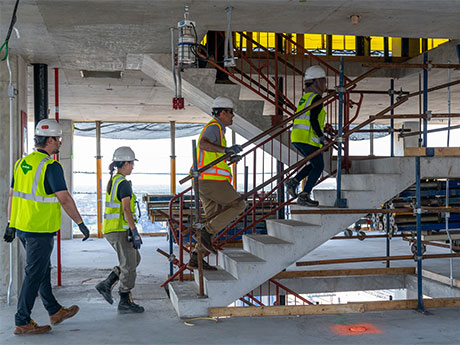Construction firms are eager to hire more employees, but a dearth of qualified workers has stymied their efforts, according to an annual workforce survey conducted by the Associated General Contractors of America (AGC) in conjunction with Autodesk. Among firms with job openings, 91 percent report they are having a hard time filling some or all positions.
A total of 1,266 individuals from a broad range of construction firm types and sizes participated in the workforce survey conducted in July and August.
Some 77 percent of contractors report there are few workers available who meet the minimum qualification standards, including being able to pass a drug test, which is something insurance companies require for all workers in the industry.
With the unemployment rate in the construction industry hovering around 4 percent, finding qualified applicants is sure to remain a challenge in the near term, says Ken Simonson, AGC’s chief economist.
“Construction workforce shortages are severe and having a significant impact on construction firms of all types, all sizes and all labor arrangements. These workforce shortages are compounding the challenges firms are having with supply chain disruptions that are inflating the cost of construction materials and making delivery schedules and product availability uncertain,” states Simonson.
August Hiring By the Numbers
The U.S. construction industry added 16,000 jobs in August compared with the prior month and 311,000 jobs yearly, an increase of 4.2 percent, according to an analysis of federal employment data by AGC. Total construction employment climbed to 7.7 million in August.
Employment in residential construction — homebuilders, multifamily general contractors and residential specialty trade contractors — increased by 10,900 in August.
Nonresidential firms added 4,300 employees in August, as gains of 700 jobs at general building contractors and 5,600 at nonresidential specialty trade contractors offset a loss of 2,000 workers at heavy and civil engineering construction firms.
Problems, Solutions in Spotlight
The survey not only pinpointed some of the industry’s biggest obstacles, but it also highlighted what steps general contractors are taking to address the problems. Among the key highlights:
- Nearly one-quarter (23 percent of respondents) say potential employees report needing flexible work schedules or an option for remote work. Twenty-one percent indicate that potential employees report difficulty acquiring reliable transportation to and from a jobsite.
- To attract and retain employees, firms have increased pay. Some 86 percent of respondents report that their firms have raised base pay rates in the past 12 months, while 45 percent of firms have provided incentives or bonuses. Twenty-four percent have increased their portion of benefit contributions and/or improved employee benefits.
- Forty-seven percent of firms are boosting spending on training and professional development programs, 25 percent are enhancing their online and video training capabilities and 16 percent are using augmented and virtual reality technology to better train workers.
- Eighty-seven percent of firms agree that their employees need to possess digital technology skills to be successful as firms adopt new labor-saving technologies. While few candidates possess the construction skills firms want, nearly two-thirds of responding firms say at least half of the people they are hiring possess the technology skills they need.
- The industry is taking numerous steps to find workers. More than half (51 percent) of firms that completed the survey — up from 37 percent in the 2021 survey — report they have engaged in a career-building program at high schools, colleges or career and technical education programs. Thirty-nine percent report they have added online strategies, like using Instagram Live, to connect better with younger applicants.
- Rising materials costs and delivery delays have caused headaches for many firms. Only 8 percent of firms report no impact on project completion times. In contrast, most firms cite four multiple causes for delayed completion times. The reason most frequently cited is delays due to longer lead times or shortages of materials (82 percent of respondents). About two-thirds cite delays due to shortages of workers (66 percent) and delivery delays (64 percent). Approximately one-third list delays due to government (34 percent), such as lack of approvals or inspectors, or delays due to an owner’s directive to halt or redesign a project (31 percent).
- Responses vary to rising materials costs. Slightly more than two-thirds of respondents (70 percent) report passing on some or all their additional costs, but 39 percent say they have tried but have not succeeded so far, and about one-third (34 percent) say they have absorbed all additional costs. Thirty-nine percent of respondents report having changed suppliers or specifications, and 9 percent have canceled orders. Only 7 percent report that items they buy have not had unanticipated cost increases.
- Firms report upcoming or expected projects were canceled, postponed or scaled back due to increasing costs (58 percent of respondents), lengthening or uncertain completion times (33 percent), or changes in demand or need (20 percent). However, 28 percent say there are more projects to bid on or that projects have been expanded in scope.
To view the complete AGC/Autodesk workforce survey results, click here.
— Matt Valley


